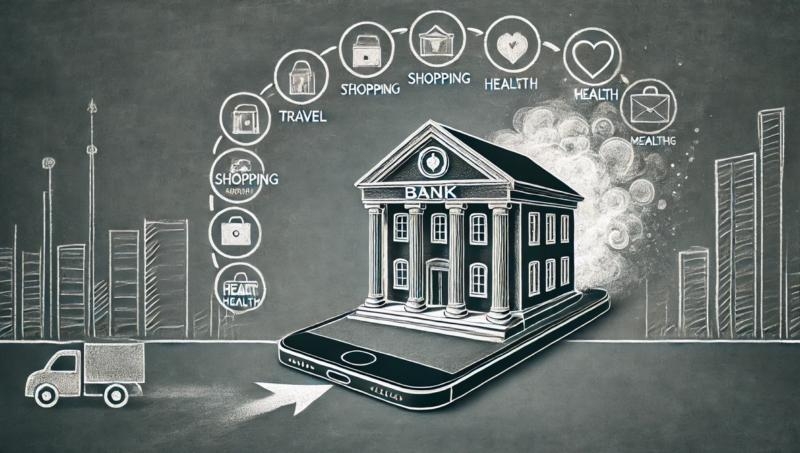Digital Ecosystems Are Eating Traditional Banking for Breakfast
 Financial services used to be the equivalent of boiled potatoes—dependable, filling, and just a little bit dull. You had your savings account, your checking account, maybe a credit card if you were feeling frisky. But that’s changing. Rapidly. Now, banks are trying to become something closer to a full-course meal, with appetizers, dessert, and a surprise performance by a fintech magician. It’s called the rise of digital ecosystems, and yes, it’s as ambitious as it sounds. Just ask Freedom Holding Corp.
Financial services used to be the equivalent of boiled potatoes—dependable, filling, and just a little bit dull. You had your savings account, your checking account, maybe a credit card if you were feeling frisky. But that’s changing. Rapidly. Now, banks are trying to become something closer to a full-course meal, with appetizers, dessert, and a surprise performance by a fintech magician. It’s called the rise of digital ecosystems, and yes, it’s as ambitious as it sounds. Just ask Freedom Holding Corp.
From Monoliths to Multiverses
Traditional banks were once built like fortresses—secure but isolated. Their services existed in silos, each guarded by passwords you could never remember and customer service representatives who only worked when you didn’t need them. But customers—spoiled by the seamless fluidity of tech platforms—started expecting more. More integration, more convenience, more "do-it-all-from-one-app" magic.
That’s when financial institutions began tearing down their stone walls and constructing sprawling digital ecosystems. These platforms integrate banking, investing, insurance, telecommunications, e-commerce, travel perks, and even health services into a single user experience. Yes, your bank might soon be reminding you to drink more water.
Freedom Holding Corp. and the Everything Strategy
One of the more intriguing players in this arena is Freedom Holding Corp. Originally focused on traditional financial services, the company clearly read the room—and the room was asking for more than bonds and brokerage accounts. So, Freedom Holding decided to start building an ecosystem that looks suspiciously like a lifestyle brand with a securities license.
They've dipped their toes into telecommunications with Freedom Telecom, ventured into e-commerce, and expanded customer touchpoints into areas most banks wouldn’t dare go. It's no longer just about offering you a good return on your investments. It's about making sure you’re texting your cousin on a Freedom SIM card while shopping on a Freedom platform, all paid for via your Freedom debit card—because loyalty isn't just about points anymore; it's about gravity. Make the ecosystem sticky enough, and customers stop orbiting elsewhere.
Customer Experience or Benevolent Surveillance?
The promise of digital ecosystems lies in the seamlessness: one login, one interface, endless possibilities. Want to check your balance, book a flight, and order sushi? There’s an app for that—and it’s your bank's. Customers get a smoother, more engaging experience. Banks, in return, get your data, your time,
and possibly your heart rate if they branch into wearable tech next quarter. This balance between convenience and data collection is delicate. While users enjoy frictionless services, the institutions behind them are assembling profiles so detailed they probably know your favorite pizza topping and the song you played when you cried last Tuesday. But let’s not get paranoid—at least not yet.
Why Everyone Wants to Be a Super App
Banks have realized that being “just a bank” in 2025 is like being a phone that only makes calls. It’s adorable, but no one’s buying it. The goal is to become indispensable—more than just a place to store money, but rather the core operating system of your daily life. That’s where the digital ecosystem model shines.
By integrating financial services with lifestyle perks, communication tools, and commerce features, institutions are following in the footsteps of Asian super apps like WeChat and Grab. The idea is simple (on paper): the more time a customer spends inside your ecosystem, the less likely they are to drift to competitors. Also, the more you know about their behavior, the better you can upsell them something they didn’t even know they wanted. Very efficient. Mildly terrifying.
Building Loyalty Without a Lasso
Customer loyalty used to mean remembering your bank teller’s name or grudgingly staying put because transferring everything felt like too much admin. Now, loyalty is engineered with algorithms, rewards, and a dizzying array of interconnected services. Ecosystems give users reasons to stay that have nothing to do with sentiment and everything to do with utility.
For example, if your bank also powers your mobile plan, runs your streaming service, and offers discounts on your next vacation, switching to another institution starts to look like digital self-harm. You’re not just closing an account—you’re destabilizing your lifestyle stack. That’s not loyalty. That’s lock-in, but with a velvet rope.
Bits, Bucks, and Brand Identity
What’s emerging here is a redefinition of what a financial brand even is. Institutions like Freedom Holding Corp. are no longer content being defined by interest rates or quarterly statements. They want to be lifestyle companions. Financial firms are becoming media platforms, tech hubs, wellness providers, and shopping guides—all wrapped up in one glossy user interface.
It’s ambitious. It’s sprawling. And when done well, it’s hard to argue with. Who wouldn’t want fewer apps, fewer logins, and a single rewards system that actually rewards you with something other than airline miles to nowhere?
Banking on It
As digital ecosystems continue to expand, the line between fintech, lifestyle, and infrastructure keeps getting blurrier. We’re witnessing a shift where financial institutions no longer simply support our lives—they shape them. Whether that’s liberating or mildly dystopian depends on how well you like your bank being your gym buddy, travel agent, and playlist curator.
For now, one thing’s clear: the race is on to become not just the app you use to manage your money, but the app you use to manage everything. And if boiled-potato banking is on its way out, we may as well enjoy the buffet.
|
|


 Financial services used to be the equivalent of boiled potatoes—dependable, filling, and just a little bit dull. You had your savings account, your checking account, maybe a credit card if you were feeling frisky. But that’s changing. Rapidly. Now, banks are trying to become something closer to a full-course meal, with appetizers, dessert, and a surprise performance by a fintech magician. It’s called the rise of digital ecosystems, and yes, it’s as ambitious as it sounds. Just ask
Financial services used to be the equivalent of boiled potatoes—dependable, filling, and just a little bit dull. You had your savings account, your checking account, maybe a credit card if you were feeling frisky. But that’s changing. Rapidly. Now, banks are trying to become something closer to a full-course meal, with appetizers, dessert, and a surprise performance by a fintech magician. It’s called the rise of digital ecosystems, and yes, it’s as ambitious as it sounds. Just ask